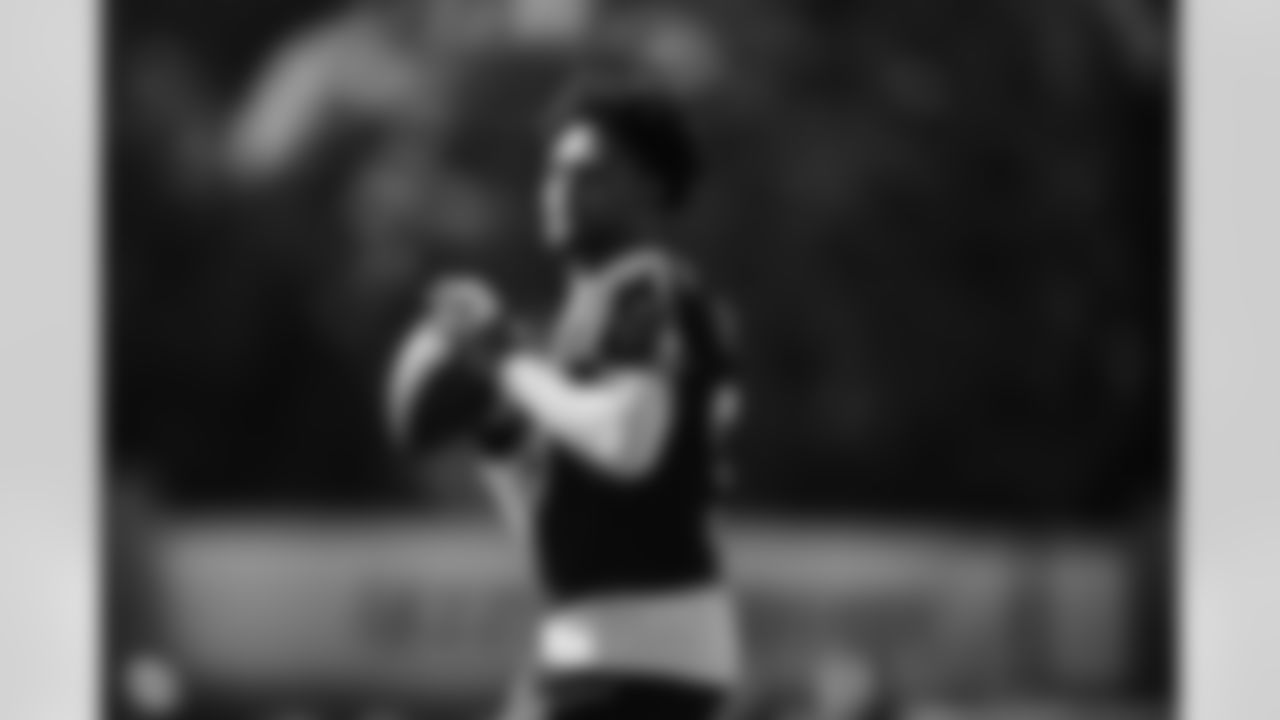CHARLOTTE—Coaches and analysts around the National Football League have spent decades, uncountable dollars and even longer hours, all to solve one equation; what is the ideal amount time for which a quarterback to throw the ball? So, leave it to Dolphins head coach Mike McDaniel to sum it up succinctly and with panache.
"Before he's sacked."
In some ways, it really is that simple. But in all deference to McDaniel's witty rapport, there is work to be done to first get to that point. It's a situation the Panthers are currently in, with new head coach Dave Canales working to lower quarterback Bryce Young throwing time to 2.7 seconds. It comes on the heels of a rookie season that saw Young absorb 62 sacks
That tied a franchise record and was the sixth-highest single season total in league history. So the idea of a passer getting the ball out quicker is not a unique conundrum. During the NFL's annual scouting combine, pulling together coaches and executives from every team to evaluate the next crop of talent, more often than not, coaches from across the spectrum of teams—Super Bowl winners to those experiencing playoff droughts—shared insight to their respective quarterback situations. Knowing the Panthers would be embarking on this journey to 2.7 seconds, it wasn't hard to listen in on some of these coaches' expertise and draw parallels.
A trio of coaches specifically—Andy Reid of the Kansas City Chiefs, Doug Pederson of the Jacksonville Jaguars and Mike McDaniel of the Miami Dolphins—peeled back the curtain a bit on what it takes to evaluate and then mold a quarterback for the NFL, a process that achieves many goals, not the least of which can lower a passer's throwing time. With that in mind, here is what two Super Bowl winning coaches and the man behind the league's best offense last season had to offer on the subject.

Including Canales, three of the four coaches whose brains were picked on this topic coach two No. 1 overall picks, two former Heisman finalists, a Heisman winner and three college championship quarterbacks, including two National Championship game offensive MVP's. Oh, and the other one is Reid, who coaches a guy named Patrick Mahomes.
But as anyone who watches the game knows, even the most impressive of college success does not equate immediate professional success. Why is that? What's changing, other than the speed, the talent level, the outside responsibilities and increased pressure? Other than all of that, could it be something as mundane as point of view.
The adage goes, "timing is everything," but timing is shaped by perspective, both figuratively and—in the case of passers moving from the college to the professional level—literally.
"I think the hash marks play a big part of it. The fields, they got more space in college football," posited Pederson, going on to note the condensed playing area is then stuffed with more formidable opponents. "The other thing too is at our level, you know, we've got draft picks in every position. We got the best of the best in every position; offense, defense and special teams where, you know, this is not a knock on college football, but they don't all have blue chip athletes in every position.
"So, space and time, the speed element can play a big factor in that."

The hashmarks in the NFL demand a more balanced approach to the pre-snap process, subsequently placing more hats near the ball. And to Pederson's point, that traffic speeds up everything in the process. When a team is transitioning a player from college to the NFL, the escalated level of competition puts a lot more pressure on the trenches as the passer adapts.
And for those coaches that have been around the championship block a few times, it's the line that sees first-hand how a quarterback adjusts to the NFL.
"I was blessed to play the offensive line, so, so I've tried not to lose that focus on it," Reid bragged.
The catch-22 is, of course, that while a good line might be able to know first what a quarterback is capable of, a bad line can skew a quarterback's evaluation and ability, perhaps more than any other position group. It's why the Panthers spent over $150 million this offseason to shore up the unit in Charlotte. The additions of guards Damien Lewis and Robert Hunt will—presumably—give Young more time to throw. More time, in turn, allows him to lower his throwing time.
"I'll be a crazy stickler about it," Canales promised in February, of pushing Young to throw at or under that 2.7 mark this offseason. "I'm selling to Ickey (Ikem Ekwonu), I'm selling to (Taylor) Moton, I'm selling to these tackles, 'Guys. Be aggressive. We're going to get the ball out so that you can just be sound in your technique.'
"We don't have to chase things, so we don't hang them out to dry within reason when we got to go."
Reid, the man who has coached Donovan McNabb, Michael Vick and Mahomes, cautions there is so much more to consider before determining if a passer has the tools to succeed in the league.
"A lot of things that go into that. Where's the staff at? Are they in their last year? Are they in their first year? What offense are you asking this guy to be in? Are you willing to work with his strengths and trying to better his, you know, the things that he's not strong at, his weaknesses; are you willing to stand before (the media) and kind of protect that guy so he can grow a little bit, all of those things come into play. There are a lot of things that take place, that help when you're a quarterback."
Once all of those puzzle pieces are into place, a coach can focus on the details, like release time, needed to make a quarterback great.
"You try to teach, I mean, that's what we're here for," Reid continued. "So, we're here to teach and it's not all about the plays. It's about how (you) teach them and then how you handle the player and how you teach that player. So there a lot that goes into it."
Few have taught better than Reid, who has made a legendary career out of using his players talents to be an ingenious play caller. The willingness to work with a QB's strengths, as Reid said, is perhaps why Mahomes holds the ball the longest amongst the interviewed coaches' passers (Mahomes, Trevor Lawrence and Tua Tagovailoa). This is offset by Mahomes' magic outside the pocket. In 2023, the Chiefs Super Bowl MVP had the fifth highest scramble rate in the league (amongst QB's who threw at least 400 passes). But it's what he does well, so Reid adapts.

Part of the Panthers' push to lower Bryce Young's throwing time harkens back to what Young did well when he was at his most successful, as passing game coordinator Nate Carroll alluded to in our first entry to the 2.7 project.
It's a process Pederson has been walking through with Lawrence in Jacksonville. Having spent the past two seasons tweaking Lawrence's game to the NFL, Pederson is now ready to merge his quarterback and his playbook into one voice.
"Continuing to understand our offense right, get better with the scheme and really still put more of an impact to his voice in our offense. Because he's the one out there executing, calling the plays. So, you know, I want him to speak up and really take ownership in that with us," Pederson said at the combine of his hope for Lawrence this season. If the former No. 1 overall pick's path can serve as a blueprint for the Panthers and Young, it'd stand to reason the next few months for Canales and company will be providing their second-year passer with all he needs to find his voice in the coming season.

Beyond all of the teaching moments, all of the offensive line updates, and hashmarks, and giving a quarterback a voice to succeed, there is still another factor to consider in helping a passer possibly reduce their throwing time. And once again, trust Mike McDaniel to sum it up best.
"I think really some of the best players in the National Football League are collected as pass rushers on the defensive front and that's some of the most strained matchups you have regardless of the team you're playing against," he said.
McDaniel has shaped his offenses, both with the San Francisco 49ers and now the Dolphins, with an identity that all boils down to one word: fast. As such, he's helped quarterbacks and pass catchers negate pass rushers that are otherwise game wreckers.
"So being able to play to that and not have the quarterback have the ball that long before he throws it, minimizes the chance for those negative plays," McDaniel continued.
When Tagovailoa first arrived in the NFL, his average time to throw was 2.55 seconds. It has ticked lower each season, and in 2023 in his second year under McDaniel, Tua was getting the ball out in an average of 2.36 seconds. It's an almost unfathomable, infinitesimal amount of time.

"Once the ball is snapped, it's basically gone," Panthers pass rusher DJ Wonnum expelled a resigned sigh, trying to put words to a span of seconds shorter than the breath he took. When it's coming out that quick, "I'm not really looking for nothing, I'm just trying to get there as quick as I can."
The fact that Wonnum and other pass rushers could actually get off the block and disrupt the quarterback in fewer than three seconds though is part of why coaches are shaving more and more time off their passer's throwing time. It's an imperfect science though, the result of an imperfect game that is determined by a 22-piece domino effect every play.
"There's a lot of variables that can go into play where guys may not be able to get open in those times," McDaniel made sure to add.
As such, he has been hesitant to put an exact time on how quickly he wants Tua and his other quarterbacks to have the ball leave their hand.
"It's not a mandate, 'you want the ball out at a certain time.' It's more that you're trying to play to the strength, your team and when things are open and when both the offensive player and the scheme allow for a player to be open early in the timing of the play, you take advantage of that because it's more difficult for the defense to have a negative play on your line of or behind it."
There is a smidge of privilege that comes with a less specific approach. Of the three outside coaches who offered expertise on the subject matter here, all have had at least two seasons with their current quarterbacks. To get to the point where they currently are though, they first had to suffer through the toils of fine-tuning their passers and their playbooks. That's where the Panthers currently are; working to lower Bryce Young's throwing time to a point in the offseason that can be manageable in the regular season.
At the end of the day though, it's all just numbers. The goal, as Mike McDaniel reminded us, is to get the ball out in such a time to beat one factor.
Before he's sacked.
Check out photos of your favorite Panthers quarterbacks during spring practice sessions.








































